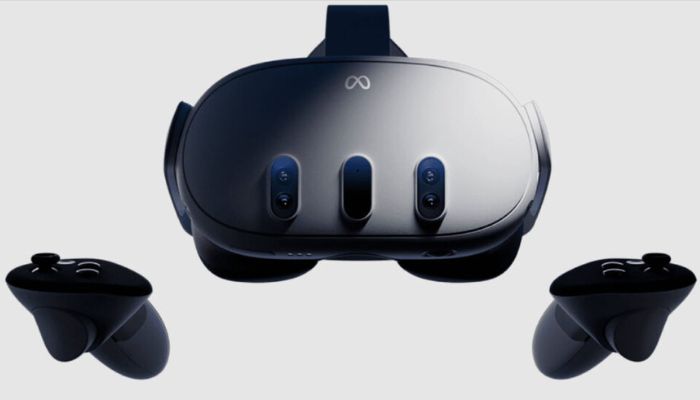The wait is over, as tech giant Apple has finally unveiled the much-hyped AR headset. Yes, the Apple Vision Pro is a reality now and is next level. The CEO Tim Cook introduced it on 5th June at an hour-long Apple developers’ conference. This means it’s time for the much-awaited Apple Vision Pro vs Meta Quest 3 analysis.
With the launch of Apple Vision Pro, the company directly competed with Meta, a dominant player in the VR headset industry. Meta has already established itself with the widely popular Quest 2 headset and plans to launch a successor, Quest 3, by the end of this year.
Given the notable differences between the two upcoming VR headsets, it is only natural that tech enthusiasts have already begun comparing them. In light of this, we have also analyzed to provide you with an overview of the two leading VR headsets currently available.
But before jumping into the Apple Vision Pro vs Meta Quest 3 battle, let’s get an overview of both groundbreaking devices.
Apple Vision Pro- An Overview:
The Apple Vision Pro marks Apple’s first foray into a new product line since the release of the Apple Watch in 2015. Instead of labeling it as just an AR headset, the company refers to it as a Spatial Computer, and there is a justification for this distinction.
The device is specifically designed to offer an immersive experience that seamlessly blends the digital and physical worlds while maintaining a connection with the real world.

Within the headset, two micro-OLED displays boasting over 23 million pixels. This revolutionary technology is also complemented by custom lenses, resulting in exceptional sharpness and clarity that delivers truly breathtaking experiences.
The Apple Vision Pro comprises many cameras and sensors that enable augmented reality passthrough functionality. However, the most noteworthy feature is the external display that allows the viewer to see the wearer’s eyes and expressions from within the device.
Apple Vision Pro uses a dual-chip design featuring two key components: the M2 chip and a newly developed chip known as R1. The M2 chip focuses on delivering high-performance capabilities, while the R1 chip is specifically designed to enhance the immersive nature of the experiences.
The R1 chip is responsible for processing input from 12 cameras, five sensors, and six microphones, enabling the device to gather a wealth of visual and audio information.
Meta Quest 3- What Do We Know:
Just three days before Apple’s anticipated Pro Vision unveiling, Meta made an unprecedented move and grabbed much attention by announcing its next-generation Quest headset. Meta asserts that this new iteration will surpass the features of its highly popular predecessor, the Quest 2. However, the true extent of its capabilities and how it stacks up against the Vision Pro remains to be seen.

Although the company didn’t reveal exact hardware specifications, it’s only fair to assume that the Quest 3 will be a step ahead of Q2 regarding performance and design. Meta has claimed that the Quest 3 will offer an improved viewing experience, a more precise and comfortable design, and superior performance.
The Quest 3 headset provides users with a medium to interact with both the virtual and real worlds seamlessly. Meta asserts that it will feature a higher resolution display than the Q2, along with cutting-edge optics. The Quest 3 will also be equipped with a more powerful Snapdragon Series 8 chipset, promising an incredibly immersive experience surpassing any currently available device.
Meta has further stated that the Quest 3 incorporates innovative machine learning and spatial understanding technologies. This allows users to immerse themselves in an environment that transcends the boundaries of today’s reality, recognizing objects in the physical space and naturally responding to them.
Apple Vision Pro Vs. Meta Quest 3: Head-to-Head:
While we eagerly anticipate the official release of detailed specifications for both recently unveiled AR headsets, much of the information has surfaced unofficially, and we already know a lot about the Apple Vision Pro and Meta Quest 3. Based on our analysis, here’s how we look at the Apple Vision Pro vs Meta Quest 3 comparison:
1. Design:
Apple Vision Pro emerges as a clear winner in terms of design. Following the design philosophy of previous Apple devices, the headset embodies the company’s commitment to creating aesthetically pleasing and ergonomic products.
It showcases a sleek combination of metal and glass, with an external display and internal screens. Reminiscent of an iPhone, it features high-quality glass and smoothly curved edges. With the attached strap, it resembles an iPhone strapped to your head, maintaining a cohesive visual identity. Additionally, the popular crown control, previously seen in the Apple Watch, appears in the Vision Pro, allowing for convenient settings adjustment.

Equipped with multiple cameras, sensors, and speakers, the Apple Vision Pro offers a truly immersive experience whether you’re browsing the web, playing games, or consuming media. Many of its features can be controlled through hand gestures and voice commands, and there’s even an option to attach the Magic keyboard or gamepad for added versatility.
However, it was surprising that Apple did not include a motion wand or dedicated controller, but you can still enjoy gaming by connecting a Bluetooth controller to the device.
Quest 3, on the other hand, may not have as extensive a design as Vision Pro, but it does the job given the price point. Meta claims that Quest 3 will be 40% slimmer than the predecessor, but it’s still far from Vision Pro in terms of design, material quality, and overall feel. Somehow It still feels like a chunkier device next to the sleek metal-and-glass design of Vision Pro.

While it features external cameras and a depth sensor to enable full-colour augmented reality passthrough, it lacks an external screen to display the wearer’s face, which we see on Vision Pro. Not that it’s the most crucial feature on a headset, but it’s better to have than not.
However, on a brighter note, while the Quest platform supports finger and hand gestures, it also comes bundled with upgraded motion controllers specifically designed for gaming and immersive applications. Something for Apple to think of.
2. Display:
The Vision Pro has impressive twin high-tech displays with over 23 million pixels combined. That’s supposed to produce extremely crisp and detailed images, perfect for enjoying AR and VR content. The company claims that each display packs more than 4K resolution that will light up your eyes.
We don’t have an official specification sheet for Quest 3, but Meta has stated that the device will have an even sharper display than Quest 2, which has a resolution of 1832×1920. How far it goes compared to Vision Pro is yet to be revealed.

According to our team, Quest 3 might have a 4K display which Quest 2 didn’t have. However, many techies are sure there won’t be a significant difference between the two, but we wait until we get our hands on the device.
3. Hardware:
The Vision Pro has Apple’s powerful M2 processor, prominently featured in recent Macs. Combined with the new R1 chip dedicated to handling data from cameras, microphones, and sensors, the Vision Pro’s performance is expected to be top-notch.
The M2 processor needs no introduction, as it is recognized as one of the most advanced processors in computing devices. It will deliver lightning-fast performance similar to that of Apple’s MacBooks.

On the other hand, the Quest 3 is set to be launched with the Qualcomm Snapdragon XR2 chip, specifically designed for AR/VR devices. While the true capabilities of this processor are yet to be unveiled, Meta claims that it will offer twice the performance of the Quest 2, which is already known for its fast performance. Whether the Quest 3 will match the performance of the Vision Pro? We eagerly await the launch to find out.
4. Software:
This is the segment where we notice a huge difference between both companies’ approaches. Vision Pro features Apple’s VisionOS, which the company calls Spatial Computer rather than a gaming headset.

The Vision Pro seamlessly integrates with iPhone and Mac, giving an added advantage for Apple users. What sets the Vision Pro apart is its positioning as a device for productivity and entertainment, going beyond the realm of VR gaming, which is the primary focus of the Quest 3.
Despite its productivity and entertainment focus, the Vision Pro can still run existing Apple Arcade games using a Bluetooth controller or the Magic Keyboard. Apple may also collaborate with developers to create VR games exclusively for the Vision Pro, although no official announcements have been made regarding this at present.
5. Battery:
The Apple Vision Pro falls slightly short in the power department as it lacks an in-built battery. Instead, users are given a plug-in pack conveniently carried in a pocket. In terms of battery life, the pack is expected to last up to 2 hours, which is relatively low by standards. However, by utilizing a wall plug, users can enjoy unlimited usage of the Vision Pro.
As for the Quest 3, no information is available regarding its battery life. However, its predecessor, the Q2, excelled in battery performance. The Q2 includes an onboard battery with up to 3 hours of uptime. Moreover, users can enhance their battery life by acquiring an Alite strap with an additional battery pack, effectively doubling the battery capacity.
Given the impressive battery life of the Q2, it is anticipated that the Quest 3 will offer an improved battery performance compared to the Vision Pro.
5. Price And Availability:
Let’s talk about the elephant in the room – the price. This is the most important benchmark for most of us before opting for either of these headsets.
The Apple Vision Pro comes with a hefty price tag of $3499, considerably higher than the expected price range of $2000-$3000. However, considering Apple’s track record, it’s unsurprising that this exceptional technology comes with a premium price. The Vision Pro is not intended for everyone, much like other high-end devices from Apple. The device is slated to be available for delivery in the US and through Apple stores starting in early 2024.

On the other hand, the Quest 3 is expected to launch with a price tag of $500, similar to its predecessor, the Quest 2. The company is sticking to its consumer-focused approach for the main Quest line, keeping the pricing affordable. Even the more advanced Quest Pro is currently being sold for $1000. It”s pretty clear who wins the Apple Vision Pro vs Meta Quest 3 price war.
Apple Vision Pro Vs. Meta Quest 3: Who’s The Winner?
It’s too early to declare a winner until we get a hands-on experience with both headsets. But, based on our analysis, a few things are clear:
- Catering to its target audience, the Meta Quest 3, just like the Quest 2, remains a proper VR gaming headset rather than a productivity device.
- Although you could play a few Apple Arcade games on Vision Pro, Apple has projected it as an entertainment and productivity device where you can view multimedia, check email, browse the web, etc.
- With the smooth integration with all Apple devices, Vision Pro can be an attractive prospect for all Apple users.
- The huge price difference is huge, and Meta Quest 3 will surely benefit from its more reasonable price compared to Vision Pro, which is seven times more expensive.
Frequently Asked Questions:
Vision Pro is an upcoming AR headset from Apple capable of VR experience, making it a perfect device for productivity and VR gaming.
Meta Quest 3 is supposed to have Qualcomm Snapdragon XR 2 processor. The official spec sheet is not available yet.
While the Apple Vision Pro excels as a productivity device, the Quest 3 is primarily designed as a VR gaming headset. However, considering the Vision Pro’s price of $3449, the Quest 3 emerges as a more favourable choice for gamers in terms of affordability.
Conclusion:
Currently, we don’t have sufficient data available to conclude. We will wait for the final product to assess both headsets’ exclusive apps, games, and overall user experience.
Apple has returned with an exceptional device featuring premium features, high-end specifications, and stunning aesthetics that showcase the strength of its ecosystem. However, the question remains: is the price tag of $3449 justified?
On the other hand, the Quest 3 appears to be a notable upgrade over its popular predecessor, the Quest 2. It offers a sharper display, a more powerful processor, and the capability to play AR games. And the most important fact – it costs one-seventh the price of Vision Pro. This alone clearly indicates who wins the Apple Vision Pro vs Meta Quest 3 contest.
I am an engineer by education, tech writer by profession, and a motor sport fan by heart.





![Largest Companies in The World 2024 [20 Most Valuable] Largest Companies In the World](https://www.newvisiontheatres.com/wp-content/uploads/2022/12/Largest-Companies-In-the-World-200x114.png)
